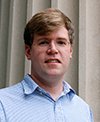Kelly Receives Grants to Study Extremely Magnified Stars

Prof. Patrick Kelly received more than $430,000 from the National Science Foundation (NSF) to study extremely magnified stars. Observing a very distant star whose image is being magnified by the gravity of a cluster of galaxies in the foreground, Kelly's group hopes to learn about stars and potentially dark matter in the form of black holes in the foreground cluster. The project will develop several exhibits for the Bell Museum. Kelly also received a grant for more than $447,000 and a large amount of time on the Hubble Space Telescope (HST) to study dark matter using similar technique.
The NSF grant will use the Large Binocular Telescope to take deep images of the galaxy cluster field. One background star has been magnified enough to be seen at a distance of billions of light years. By obtaining a three-year light curve of the single, highly magnified star, using the Large Binocular Telescope, they will be able to measure microlensing light fluctuations. Kelly's research aims to allow astrophysicists to determine how many low and high mass stars exist along the line of sight through the cluster. These observations will provide new information about the initial mass function (IMF), a poorly understood but fundamental characteristic of populations of stars, in galaxy clusters.
The HST program will help Kelly try to understand whether and why the number of microlensing events, where individual background stars temporarily become highly magnified by objects in foreground galaxy cluster lenses, may be greater than expected. One theory is that objects such as black holes accounting for a fraction of dark matter could cause an elevated rate of microlensing events. The same, extremely deep HST observations will also obtain evidence about whether dark matter could consists of ultra-light bosons, as some theoretical models have predicted.
Professor Kelly is a faculty member in the School of Physics and Astronomy and a member of the Minnesota Institute for Astrophysics.